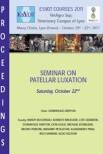Objective-To develop an in vivo CT method to measure inclination angles and motion of the sacroiliac joints in dogs of performance breeds. Animals-10 German Shepherd Dogs and 12 Greyhounds without signs of lumbosacral region pain or neurologic problems. Procedures-CT of the ilium and sacrum was performed in flexed, neutral, and extended hind limb positions. Lines were drawn on volume-rendered images acquired in the flexed and extended positions to measure motion of the ilia relative to the sacra. Inclination angles of the synovial and ligamentous components of the sacroiliac joints were measured on transverse-plane CT images acquired at cranial and caudal locations. Coefficients of variance of measurements were calculated to determine intraobserver variability. Results-Coefficients of variance of measurements ranged from 0.17% to 2.45%. A significantly higher amount of sacroiliac joint rotational motion was detected for German Shepherd Dogs versus Greyhounds. The cranial synovial joint component had a significantly more sagittal orientation in German Shepherd Dogs versus Greyhounds. No significant differences were detected between breeds for x- or y-axis translational motion or caudal synovial or ligamentous joint component inclination angles. Conclusions and Clinical Relevance-The small amounts of sacroiliac joint motion detected in this study may buffer high-frequency vibrations during movement of dogs. Differences detected between breeds may be associated with the predisposition of German Shepherd Dogs to develop lumbosacral region signs of pain, although the biological importance of this finding was not determined. Future studies are warranted to compare sacroiliac joint variables between German Shepherd Dogs with and without lumbosacral region signs of pain.
Computed tomographic method for measurement of inclination angles and motion of the sacroiliac joints in German Shepherd Dogs and Greyhounds.
Date
2013 Sept
Journal
AJVR
Volume
74
Number
9
Pages
1172-82









